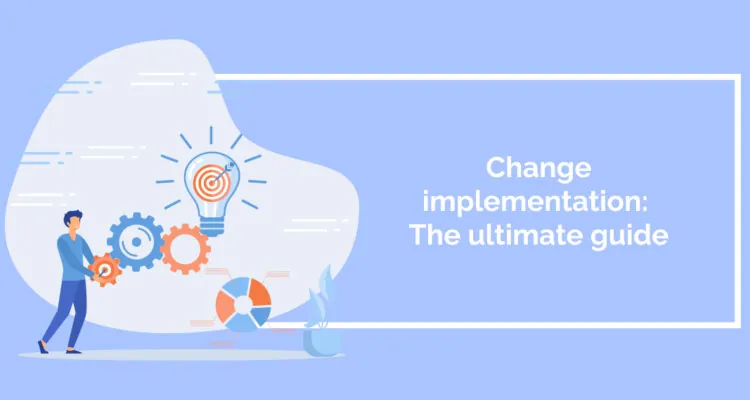
Successfully managing change in the workplace is a complex task. Resistance to change is common, often involving moving away from familiar routines. Employees accustomed to traditional methods may feel insecure about acquiring new skills.
Effective businesses excel in guiding their teams through these transitions. They recognize the value of adopting new business practices and communicate this effectively.
These leaders highlight that while change has its costs, the price of stagnation is far higher in the long term. Their ability to elucidate the rationale behind change, benefit from its advantages, and reduce its risks is crucial to success.
By the end of this guide, you will understand:
- What change implementation is and why it is essential.
- The stages, advantages, and disadvantages of change implementation.
- The factors affecting change implementation.
- A step-by-step strategy for implementing change.
What does change implementation mean?
Change implementation is a strategic process that involves implementing new methods or making modifications to enhance the functioning of a team or organization.
This can range from minor adjustments to current procedures (such as adding a step to a team’s workflow) to successful workplace transformation in existing structures (like company culture changes) or introducing new systems, software, or initiatives. The former is considered to be adaptive changes, while the latter are transformational changes.
Effective change implementation necessitates proficient change management. This process aids employees in adapting to organizational shifts through the use of diverse tools and strategies.
Why is change implementation important?
Change is vital for any organization as it assists in identifying areas for improvement and implementing vital adjustments for a more efficient system. Successful change management strategies lead to a more cohesive and organized team, even amidst process alterations.
An organization that adeptly implements changes can smoothly navigate shifting markets and needs, maintaining productivity, profitability, and unity.
A well-executed change implementation strategy paves the way for the future of work. Over time, this approach reduces employee resistance to change, encouraging them to embrace new methods enthusiastically.
Moreover, a standardized and repeatable process for implementing change enables swift action without repeatedly starting from scratch. With a solid foundation in place, more time and energy can be devoted to the finer details of future change initiatives.
Conversely, ineffective change implementation by organizations can lead to employee resistance or disregard for new initiatives, favoring existing practices. This can cause significant disruptions in processes, vision, products, and the organization.
The stages of change implementation
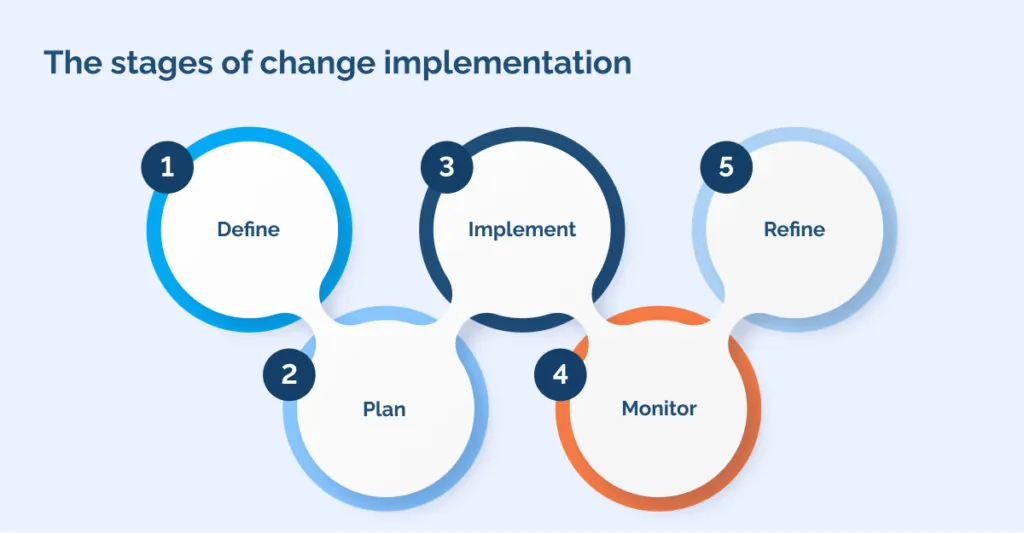
Effective change management is typically a cyclical and iterative process rather than a straightforward journey from beginning to end. Viewing it in this light helps prioritize tasks and set realistic timelines.
The different stages of change implementation are:
Define
Initially, the ‘Define’ phase involves establishing the rationale and necessity for the change, selecting the innovation to be implemented, and determining the resources to be allocated.
It’s crucial at this stage to consider key contextual elements, aiming not to remove all uncertainty but to clarify priorities and indicate the expected approach (e.g., structured or agile, collaborative or directive).
Plan
During the ‘Plan’ phase, the focus shifts to detailing the innovation, forming the implementation team, developing a comprehensive plan (or setting guidelines for an adaptive planning process), and outlining measurement, training management systems, and communication strategies.
This phase may also include strategies for communicating the change and handling employee resistance.
Implement
Once you have determined and prepared for the needed change, the ‘Implement’ phase involves rolling out this change to the broader organization.
Monitor
While change is being implemented, it is vital to continuously gather data and feedback to monitor the success of change implementation. Monitoring is even more important to assess where adjustments are made to improve outcomes.
The focus is on ensuring that the change in the everyday practices and culture of the organization ensures long-term adherence at both the individual and organizational levels.
Refine
This stage focuses on honing your future strategy for implementing change, aiming for a more streamlined process. As time progresses, your methods for executing changes will also evolve. A more structured and systematic approach will facilitate targeted business process optimization enhancements.
While controlling every aspect of a change initiative is impossible, maintaining consistency is crucial. This uniformity allows for precisely identifying your approach’s strengths and weaknesses, enabling you to make the necessary adjustments to enhance your team’s future performance.
Advantages of change implementation
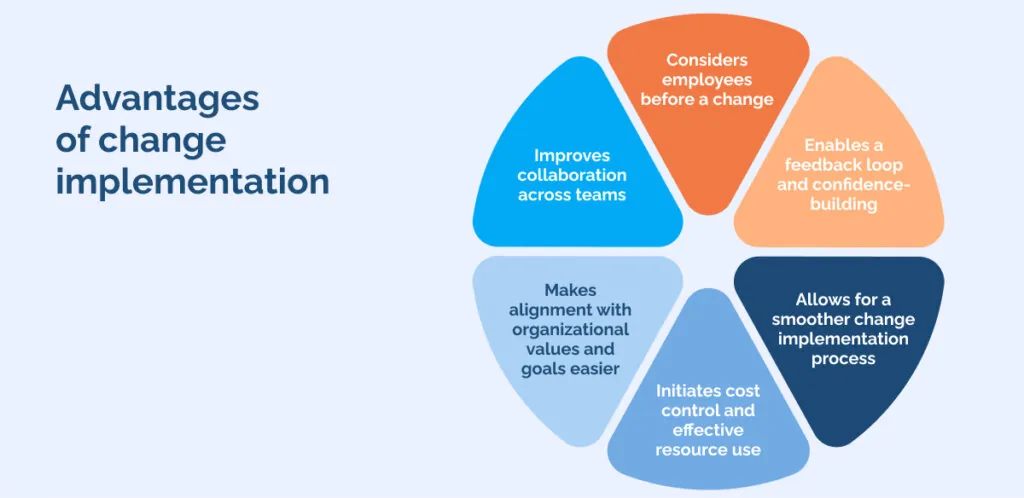
Organizational changes are typically made to enhance efficiency in achieving business goals or modify processes for new objectives. The nature of these changes depends on the organization’s goals and industry.
Key benefits of having a strategy to implement change effectively include:
Improves collaboration across teams
A good change implementation process helps employees from different departments understand their role in the change and the expected new behaviors. This fosters better cross-functional collaboration, contributing to the success of the change.
Considers employees before a change
Transparency about upcoming changes allows employees to make informed decisions. Clear, organization-wide communication minimizes repetitive inquiries, allowing leadership to focus on high-priority tasks and make better decisions. Uniform information distribution strengthens communication and aligns everyone toward the change’s shared goal.
Enables a feedback loop and confidence-building
Communicating about an impending change and seeking employee feedback ensures concerns are addressed, helping staff feel confident that the change will be beneficial.
Allows for a smoother change implementation process
Anticipating potential obstacles or resistance and planning accordingly ensures a smooth change rollout. Leveraging internal stakeholders who support the change can foster company-wide acceptance.
Initiates cost control and effective resource use
Communicating the change implementation plan to employees helps them understand the rationale behind new projects or programs, improves adoption rates, and ensures a better return on investment.
Makes alignment with organizational values and goals easier
When implementing change, aligning it with the company’s values and tying it to specific, measurable business goals is crucial. This approach confirms the change’s effectiveness and reinforces its value by demonstrating a tangible business impact.
Challenges you may face when implementing change effectively
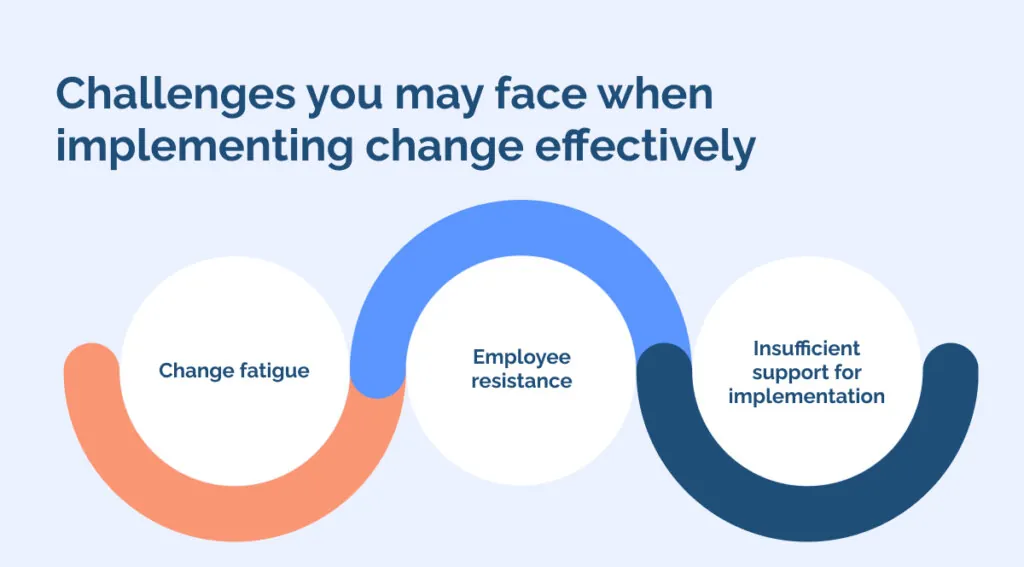
Implementing change in an organization is a complex task.
Here are some potential difficulties you might encounter:
Change fatigue
Employees can become overwhelmed and exhausted when an organization undertakes too many changes simultaneously without effective prioritization. This fatigue hinders their ability to complete tasks and projects successfully.
Employee resistance
Resistance is a natural reaction to change and should be acknowledged and addressed. This resistance can be due to fears about job security, alterations in responsibilities, or cultural shifts, leading employees to perceive change as a risk.
Resistance to change can also result from a lack of clarity or alignment with the organization’s goals and reasons for the change. If team members fail to understand how the change fits into the larger organizational vision, their buy-in will likely be limited.
Preparing for organizational change crucially involves equipping employees to adapt to new methodologies. Without assessing readiness for change, the process becomes fraught with challenges.
Regardless of talent and dedication, employees need adequate resources (such as instructions, tools, and training) to embrace the change. Failing to provide these essentials can significantly reduce the likelihood of successful change implementation.
Insufficient support for implementation
Without the backing of both senior management and employees, implementing change can be an uphill battle. Support from all levels is crucial for the successful change management adoption.
Factors affecting change implementation
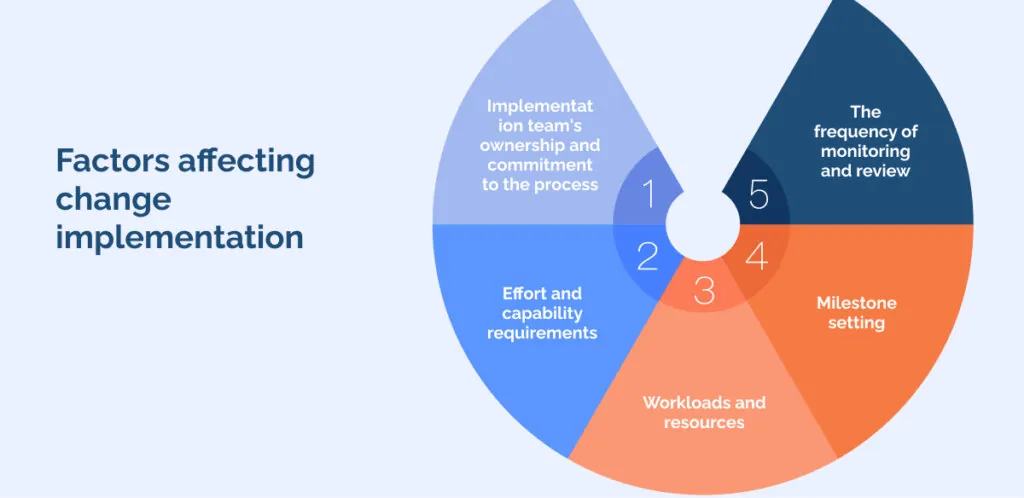
When implementing a change initiative in an organization, it’s essential to understand and manage several key factors to ensure success. These include:
Implementation team’s ownership and commitment to the process
A dedicated implementation team of individuals skilled in project management, analysis, training, and communication is essential. This team plans and executes key activities and interacts with end-users and other stakeholders.
Regular updates and reports from this team to the broader organization are crucial for maintaining accountability.
Effort and capability requirements
Acknowledging that employees already have significant workloads is essential. Adding more to their workload for the change initiative could lead to resistance, reduced morale, and potential conflicts.
Measuring the extra effort required is vital, and reducing regular responsibilities for key players in the change process is critical.
Workloads and resources
Deciding how to balance regular work with the demands of the change initiative is critical. This may involve temporarily relieving key employees of non-essential tasks, reassessing the priority of other projects, or bringing in temporary help to ease the workload during the transition.
These decisions should be carefully considered for their impact on costs and timelines.
Milestone setting
Setting meaningful milestones helps in assessing progress when implementing change. Effective milestones should reflect significant achievements rather than daily activities, enabling stakeholders to gauge real progress.
If a milestone is at risk of delay, it’s essential to understand why, address the issue, and learn from the experience to avoid future problems.
The frequency of monitoring and review
Regularly reviewing change initiatives is crucial. Projects reviewed frequently, even long, have a higher chance of success than shorter projects with infrequent reviews.
Conducting formal reviews at least every two months is advisable, as the likelihood of encountering issues increases significantly if reviews are more spaced. Complex projects may require fortnightly reviews, while simpler ones can be reviewed every six to eight weeks.
A step-by-step strategy for implementing change
Effective change management involves a structured multi-phase approach to ensure a smooth transition. Here are step-by-step instructions for successful change implementation in your organization:
1. Identify the change needed
It’s crucial to discern which changes will genuinely benefit your company. Analyze the current problems of your business, the expected benefits of change, and the desired behavioral outcomes.
Go beyond superficial solutions to address the root causes. Additionally, conduct an organizational readiness assessment to understand how the change impacts different levels and identify who needs the most support or training.
Align all changes with your organization’s vision, mission, and business objectives.
2. Guage initial employee feedback
Change requires support from both the top and bottom of the organization. Create awareness of the issues necessitating change and foster a sense of urgency.
Begin by engaging employees in identifying current challenges and intensifying the need for change by discussing the consequences of inaction.
3. Form a change implementation team
Appoint a dedicated leader or a group of leaders to spearhead the change initiative. Choose coordinators to facilitate communication and address queries regarding the change.
Identify change champions across various departments and levels – individuals who are highly motivated, proactive, and passionate about your organization’s mission. Consider how this team’s success will be evaluated.
4. Develop a plan based on your above feedback and assessment
After completing the initial stages of preparation, use the gathered insights to develop a detailed implementation plan. This plan should outline the path forward for your organization, including the steps to achieve the necessary changes and methods for evaluating their success.
Based on your impact assessment, your plan should address the needs of the most affected employees. Include support mechanisms such as mentorship programs, change management training for employees, and open-door policies for assistance and clarification. Tailor this support to the specific requirements of different employee groups.
Revisit your organization’s overarching goals with stakeholders to ensure alignment. Collaborate with your team to identify the resources needed for effective and efficient change implementation.
Establish a timeline for the plan, considering available resources and any higher-level directives. Since change processes can be lengthy, it’s crucial to have a well-conceived timeline shared with all parties involved.
Clearly define what is expected from each department and individual, especially if the rollout is staggered. Detail each group’s specific responsibilities and timelines, ensuring everyone understands their role in the change process.
5. Relay your implementation plan to your employees
To successfully implement change and ensure employee buy-in, you must communicate with them before implementation. A communication strategy should clearly define the core messages about the change. These should cover the change, its necessity, and how it will benefit the organization and employees.
Recognize which segments of your organization will be most impacted by the change. The impact assessment already conducted will inform you which levels or departments should be prioritized in the communication plan.
At this stage, determine the most effective mediums for disseminating information: meetings, emails, internal newsletters, or other communication platforms.
Initiate open and ongoing dialogue with employees, especially those most affected. Regular updates and open discussion forums will help manage concerns and build trust.
During meetings or communications, provide complete transparency about the change. Explain the issues it addresses, the expected impact on daily operations, and the overall timeline. Be clear about the final deadline to set concrete expectations.
Allocate sufficient time for employees to ask questions and express their thoughts. This interaction is crucial for understanding employee concerns and demonstrating that their opinions are valued.
6. Initiate a trial run of the change
For any change in your organization, whether integrating new technology, modifying workflows, or reorganizing teams, conducting a pilot test is beneficial.
This trial should involve members of your change management team and select representatives from each team impacted by the change.
Typically, the pilot should last about two weeks, giving enough time to evaluate its effectiveness and identify any issues.
After the trial period, organize one or more feedback sessions. During these meetings, discuss various aspects of the change: what worked well, areas needing improvement, general observations, concerns, and participant compliments.
Use this employee feedback loop and be open to making necessary adjustments based on their input.
Use the insights gained from the trial run to refine and improve the change process. Address any challenges or obstacles identified during the pilot phase.
Conduct as many training sessions as needed after the trial and before the full-scale implementation. These sessions ensure that all employees affected by the change are well-prepared and equipped with the necessary skills and resources to adapt successfully.
7. Implement the change
Adhere to your established timeline and proceed with the change implementation across the organization, aiming to have it fully integrated by the set deadline. The management team should be prepared to address any questions or concerns that emerge both immediately before and after this deadline.
As your team progresses with the change, acknowledge your team’s efforts, small victories and improvements can create the best employee experience, providing practical and emotional encouragement.
Be vigilant about any problems or setbacks that arise. It’s crucial to resolve these issues quickly to prevent them from escalating and potentially jeopardizing the project’s success.
Regularly update your team and employees on how the change affects their work and what they can expect in the future. Maintaining transparency about the change’s impact and ongoing developments will help manage expectations and align with the goals.
8. Monitor and sustain the change
As you roll out changes across your organization, it’s essential to continually oversee the implementation to ensure adherence to the intended procedures. Whether you supervise this process or delegate monitoring duties to supervisors depends on your role.
Especially in the early stages of implementation, consider evaluating progress daily or at least weekly. This frequent oversight allows you to quickly identify and rectify any unforeseen issues and understand any unexpected outcomes arising from the change.
Involve your employees or team in defining the metrics for success. Collaborative discussions can provide insights into the most relevant and meaningful ways to measure the effectiveness of the change.
Evaluate which aspects of the business have improved since the change’s initiation. It’s also crucial to identify if there have been any adverse effects, such as a decrease in employee productivity, and to understand why these have occurred.
Based on your observations and feedback, be ready to adjust your implementation strategy. This might involve additional training, altering timelines, or modifying procedures to better align with the goals of the change.
Final thoughts on change implementation
Implementing change across an entire organization is a complex and dynamic task. It involves synchronizing various elements of the organization to work together effectively. To enhance the likelihood of successful change implementation, it’s important to follow a structured approach.
First, you need to articulate what the change is, its purpose, and its expected outcomes clearly and concisely. This clarity helps everyone in the organization understand the rationale behind the change.
Then, evaluate how the change will affect different groups within the organization. Understanding these impacts allows for better planning and support for those most affected.
Next, create a plan for how the change will be communicated throughout the organization. This strategy should ensure that all employees are informed, understand their role in the change, and know the benefits and challenges.
More importantly, you must equip employees with the necessary skills and knowledge to adapt to the change. This could involve training programs, workshops, or access to new tools and resources.
Finally, keep track of the implementation progress, gather feedback, and make adjustments as necessary. Continuous monitoring helps identify issues early and allows timely interventions to keep the change on track.
WalkMe Team
WalkMe spearheaded the Digital Adoption Platform (DAP) for associations to use the maximum capacity of their advanced resources. Utilizing man-made consciousness, AI, and context-oriented direction, WalkMe adds a powerful UI layer to raise the computerized proficiency, everything being equal.



